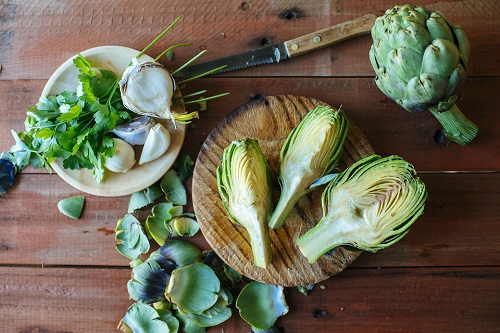Food Facts Friday: Artichokes

In a creamy dip, on top of mouthwatering chicken, or mixed into a delicious pasta dish, artichokes are a versatile and tasty kidney-friendly vegetable.
Many vegetables are naturally low in calories and fat, and a good source of fiber, vitamins and minerals. Artichokes are high in fiber, vitamin C and magnesium.
Artichoke Origins and Varieties
Artichokes are grown in many Mediterranean countries such as Spain, Italy and France. Meanwhile, the artichoke capital of the United States is Castroville, California. Artichokes come in a variety of colors including white, green and purple. Surprisingly, the edible part of an artichoke, the heart or choke, consists of the buds of the flower before it blooms. The whole artichoke with leaves is called a globe.
Artichokes are available in many forms. The most popular is canned artichoke hearts, in oil or marinade. However, artichokes are also available frozen and fresh. Artichokes are often enjoyed boiled or steamed, and served with a vinaigrette, hollandaise, mayonnaise, or aioli for dipping. Boiling an artichoke reduces potassium more than steaming.
Nutrition Facts
Fresh Boiled Artichoke Globe– 1 half globe
- Calories 31
- Protein 2 g
- Carbohydrates 8 g
- Fat 0 g
- Sodium 36 mg
- Potassium 171 mg
- Phosphorus 44 mg
- Calcium 13 mg
- Fiber 3 g
Canned Artichoke Hearts in Oil – ½ cup
- Calories 79
- Protein 2 g
- Carbohydrates 7 g
- Fat 6 g
- Sodium 36 mg
- Potassium 170 mg
- Phosphorus 44 mg
- Calcium 12 mg
- Fiber 3 g
Artichokes and a Kidney-Friendly Diet
Artichokes can be included in a kidney-friendly diet, however be mindful when it comes to potassium. One cup of canned artichoke hearts contains 340 mg of potassium, which can add up quickly if combining with additional high potassium foods. A kidney-friendly portion for a low-potassium diet is 1/2 boiled artichoke globe or 1/2 cup artichoke hearts. When making a meal or snack with artichokes, include a low potassium side like rice or pasta. Look for frozen or canned artichokes without salt or oils added. Be mindful of sodium content and read the nutrition facts label. If you are using canned or jarred artichokes, rinse the artichokes well to help reduce sodium.
Check out DaVita’s delicious artichoke recipes or try adding artichokes to one of the healthy pasta or chicken dishes below.
Healthy Artichoke Recipes

- Are You Kidding Me Artichoke Dip
- Artichoke Relish on Toasted Pita
- Pasta Primavera
- Easy Pantry Pasta
- Easy Crispy Lemon Chicken
- Chicken and Rice Casserole
References
- https://en.wikipedia.org/wiki/Artichoke. Accessed July 31 2020.
- https://www.choosemyplate.gov/eathealthy/vegetables/vegetables-nutrients-health. Accessed July 31 2020.
Additional Kidney Diet Resources
Visit DaVita.com and explore these diet and nutrition resources:
- DaVita Food Analyzer
- DaVita Dining Out Guides
- DaVita Kidney-Friendly Recipes
- Today’s Kidney Diet Cookbooks
- Diet and Nutrition Articles
- Diet and Nutrition Videos
- Kidney Smart® Virtual Classes
This article is for informational purposes only and is not a substitute for medical advice or treatment. Consult your physician and dietitian regarding your specific diagnosis, treatment, diet and health questions.

Recent Comments